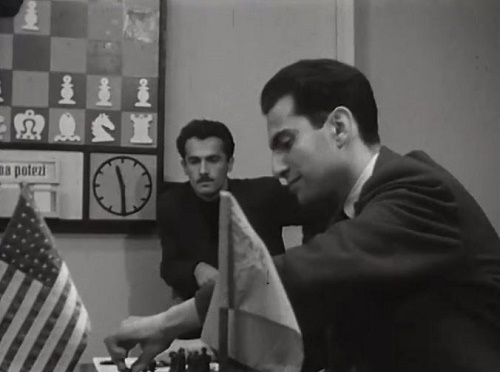
Edward Winter

A miscellany of C.N. items about Mikhail Tal (1936-92).
***
The knight fork is illustrated by the game Blek-Tal, Latvian Championship, Riga, 1955:
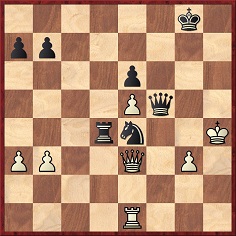
The future world champion now played 37...Nd2+ 38 Qxd4 Nf3 mate. A true family fork.
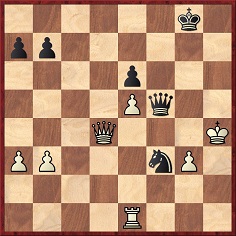
Source: Weltgeschichte des Schachs: Tal.
(822)
A comment by George Botterill from page 347 of the August 1975 BCM:
‘You cannot make a move better than it is by wishful thinking, or by admiration for the spirit in which it is played. Otherwise we could all be Tals.’
(826)
As regards hypnosis and chess, C.N. 995 pointed out an article by Lev Alburt and Harvey Simon in CHESS, August 1983, pages 63-68. Our item also quoted, courtesy of John Roycroft (London), a passage from pages 124-125 of Jeu d’échecs et sciences humaines by Jacques Dextreit and Norbert Engel (Paris, 1981):
‘Dans un article paru dans la revue soviétique 64, figure un extrait d’un ouvrage psychologique récent. Le texte de l’article est le suivant:
“Nous avons invité dans notre laboratoire l’ex-champion du monde Michel Tal, qui a joué six parties avec un de nos sujets. Il en a joué trois en état d’hypnose; on lui avait suggéré comme modèle Paul Morphy ... Pour les trois autres il était dans son état normal. M. Tal a gagné. Après la séance il a jugé le jeu du sujet comme suit: Avant l’hypnose mon adversaire savait tout juste la marche des pièces. Après l’hypnose, c’était un tout autre homme qui était assis devant moi, expansif, énergique, audacieux, qui jouait deux catégories au-dessus.”
Si l’on fait abstraction du problème plus général de l’hypnose et du travail de Tikhomirov, Reikov et Peresolskaia pour nous en tenir à l’article cité, une seule explication doit être retenue: l’article a simplifié de manière abusive le compte rendu scientifique, sacrifiant une fois encore le sérieux au spectaculaire, au point d’en faire une caricature grossière.’
The book specified that the translation, by Raymond Lhoste, of the article in 64 had been published on page 12 of the April 1976 Europe Echecs. Subsequently (in C.N. 1083) William Hartston (Cambridge, England) mentioned that a book which he co-authored with P.C. Wason, The Psychology of Chess (London, 1983), gave an account of the Tal experiment (see pages 100-101).
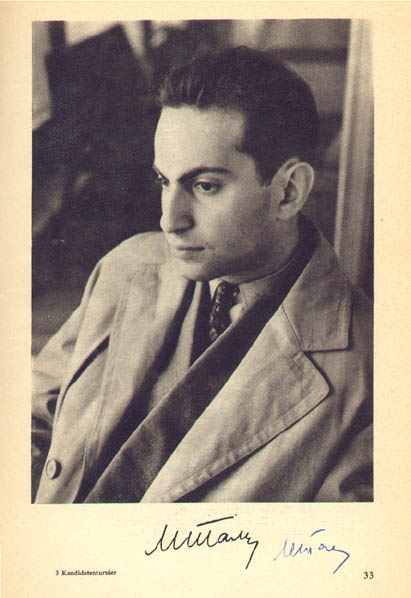
Mikhail Tal
From Ed Tassinari (Scarsdale, NY, USA):
‘On page 182 of the 1962 World Book Year Book (the annual supplement to the World Book Encyclopedia and a review of the events of 1961), the following can be found, written by Theodore O’Leary:
“Mikhail Botvinnik, 49 year old Russian engineer, recaptured his world chess title at the international masters’ tournament held in May in Bled, Yugoslavia. Botvinnik defeated the 24 year old Mikhail Tal of Latvia, who had snapped the Russian’s 12 year victory streak the year before.
Runner-up at Bled was 18 year old Bobby Fischer ... He also beat Tal at the Bled matches, but came in second to Botvinnik because of draws with lesser players.”’
(1664)
In C.N. 238 W.D. Rubinstein (Victoria, Australia) pointed out that the game below, taken from pages 113-114 of The Chess Sacrifice by V. Vuković (London, 1968), did not appear to have been published in any Tal monograph. We appealed for further details, without success.
Mikhail Tal – Alexander Koblentz
‘Training Game’, Riga, 1961
Sicilian Defence
1 e4 c5 2 Nf3 d6 3 d4 cxd4 4 Nxd4 Nf6 5 Nc3 a6 6 Bg5 e6 7 f4 Be7 8 Qf3 Qc7 9 O-O-O Nbd7 10 Be2 h6 11 Bh4 b5 12 e5 Bb7
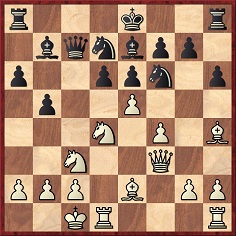
13 exf6 Bxf3 14 Bxf3 d5 15 Nxe6 fxe6 16 Bh5+ g6 17 Bxg6+ Kf8 18 fxe7+ Kg7 19 Bg3 Nf6 20 Rhe1 b4 21 Rxe6 bxc3 22 f5 Qb7 23 b3 Qd7 24 Be5 Qxe6 25 fxe6 Kxg6 26 Rf1 Nh7 27 Bxh8 Rxh8 28 Rf8 Rxf8 29 exf8(Q) Nxf8 30 e7 Kf7 31 exf8(Q)+ Kxf8 32 Kd1 and ‘White won in a few moves’.
In his book on the former world champion, Talj, Šahovski Umjetnik I Borac (Zabreb, 1964) Koblentz gave examples of his games against Tal, but not the remarkable one published here.
(2046)
Mikhail Tal died in 1992, but even reporting that elementary fact has proven an insurmountable hurdle for a number of writers. Other years proposed include:
1991: Larry Evans on the ‘Chess master Network’ (Internet).
1993: Graham Burgess on page 496 of The Mammoth Book of Chess.
1994: Bjarke Kristensen and Don Maddox on page 19 of their book about the Kasparov v Anand match.
Not to be outdone, pages 50 and 368 of World Champion Openings by Eric Schiller refer to a game ‘Unzicker v Tal, Hamburg, ...1996’.
(2240)
From page 78 of George Koltanowski’s book TV Chess (1968) we reproduce the following, with no comment or surprise:
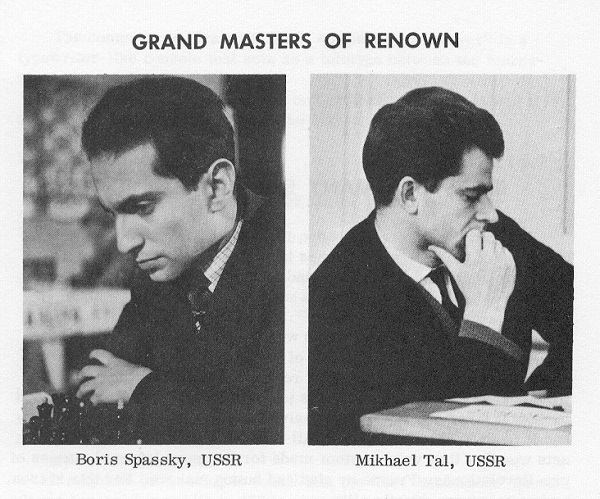
(2858)
Euwe played Tal once only, as he stated when, in an interview shortly before his death, he was asked by Hans Bouwmeester whether he had played against all the world champions apart from Steinitz:
‘I have played them all except Spassky and Karpov. Fischer three times; Tal just once, by radio.’
Source: CHESS, September 1981, page 197.
The game-score and a few details (we should like more) are given at Tim Krabbé’s website:
(3331)
C.N.s 3159 and 3170 (see pages 279-280 of Chess Facts and Fables) discussed a famous Tal victory (1 e4 c5 2 Nf3 d6 3 d4 cxd4 4 Nxd4 Nf6 5 Nc3 g6 6 Be3 Bg7 7 f3 Nc6 8 Qd2 Bd7 9 O-O-O Rc8 10 Kb1 Qa5 11 g4 h6 12 h4 a6 13 Be2 Ne5 14 g5 hxg5 15 hxg5 Rxh1 16 gxf6 Rxd1+ 17 Nxd1 Qxd2 18 fxg7 e6 19 g8(Q)+ Ke7 20 Qxc8 Resigns), noting that secondary sources have given it various dates from 1958 to as late as 1970.
On pages 41-42 of the March 2006 CHESS it was pointed out that the conclusion to the game was on page 166 of The Chess Psychologist World Champion Tal by A. Liepnieks (published by the North American Latvian Chess Association in 1961), and that the full score was included in the Tal volume in the Weltgeschichte des Schachs series, brought out the same year. Both books had ‘N.N.’ as Tal’s opponent, both stated that the venue was Stuttgart, and the latter work (in which Tal himself was involved) had the date 1958. CHESS also mentioned that the game was given in ‘the Russian bulletin Interzonal Tournament and 13th Olympiad, No. 20, 19 November 1958’, and that the 5 November 1958 issue of Schach Echo recorded Tal’s score in a simultaneous display in Stuttgart as +38 – 6 =1.
Our previous C.N. items noted that some sources identify Black as ‘Feuerstein’ and that a Cuban book put ‘Shmith’ [sic]. Could a reader with access to the Stuttgart newspapers of the time kindly check whether the Tal game appeared there and, if so, whether Black was named?
(4266)
Dan Scoones (Port Coquitlam, Canada) sends page 12 of the inaugural issue (1/1959) of Tal’s magazine Šahs:
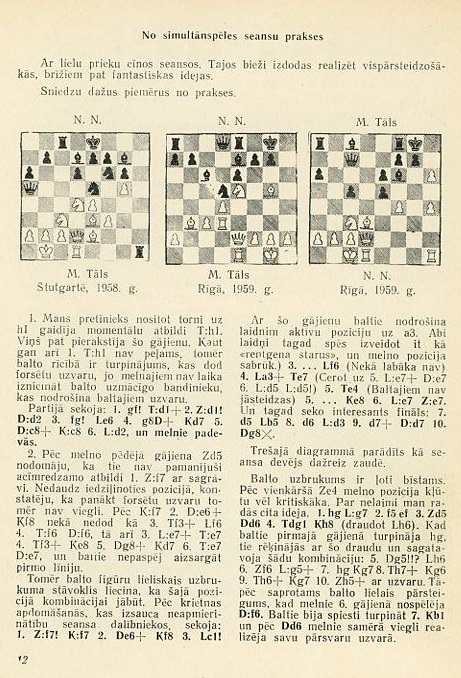
(10297)
Bruce Monson (Colorado Springs, CO, USA) writes:
‘I wonder if anyone can bring light to the following intriguing mystery involving Tal. In the May 1967 BCM (pages125-127) there was an interview with him, reprinted in English from a weekly publication of the Russian Federation Writers’ Union. Tal relates a story about his encounter with a mental patient:
“I recall an incident, a tragic one, I would say. I was the world champion at that time, and a psychiatrist friend of mine, also a strong player, made the following request to me one day:
‘Misha’, he said, ‘please play a game with one of my patients, and see to it that you win absolutely.’
‘Why don’t you do it yourself?’
‘I can’t. The chap is 26 years old and thinks he’s the world’s greatest chessplayer, claiming easy victories over Chigorin and Lasker. Only a rude shock can get him out of this state of mind. That’s why I’m asking you to play with him.’
I agreed, and went over to the mental hospital. I was introduced to the young man, who repeated his story of victories over long-dead champions. He raised no objection to a game with me, and even tried to please me by removing one of his rooks, to give me an advantage. I managed to get him to agree to play on equal terms.
You can imagine how I felt when I soon realized that I was losing. And, no matter how hard I tried, I lost. The chap suggested that we play another game. You can take my word for it, the strain in this game was far greater for me than in the world title match. With tremendous effort, I succeeded in beating that fellow in the next two games. He condescendingly observed that I wasn’t such a bad player.
‘But you should have seen how Chigorin and Lasker played’, he added.
We met again three months later at a mass-scale chess competition. I recognized him and I told my friends: ‘That’s the man who’ll win today.’
‘How do you know?’, my friends asked.
‘You just wait and see’, I replied.
I decided to play with that mental hospital patient in my first game, but as soon as it started I realized that he had advanced to the second-category ranks: my psychiatrist friend had cured him after all.”
Does anyone know the identity of this mystery “mental patient”? Is there a record of any game-scores having been kept by Tal?’
The full interview also appeared on pages 120-121 of the May 1967 Chess Life. In the final sentence quoted above it had ‘shifted’, not ‘advanced’, and in the context the former word seems more logical.
(4354)
From page 187 of the 29 February 1964 issue of CHESS (editor: B.H. Wood):
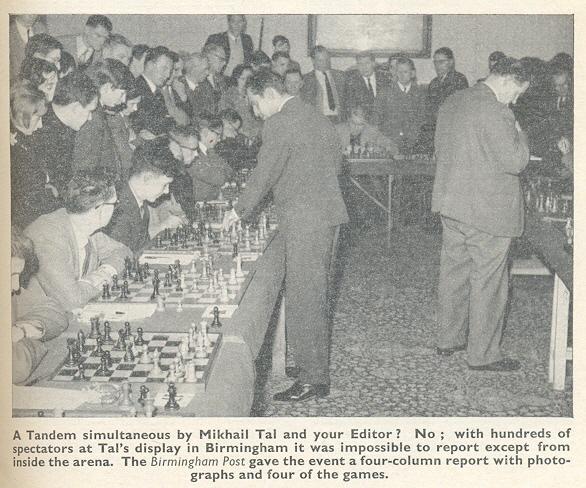
(4899)
See too Mikhail Tal in London (1964).
Jon Crumiller (Princeton, NJ, USA) recalls a passage on page 205 of The Life and Games of Mikhail Tal by M. Tal (New York, 1976). It comes from Tal’s note to his 28th move (...Bf4) against Botvinnik in game six of their 1960 world championship match:
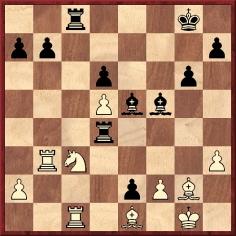
‘Unfortunately Black missed a possibility to end the game quickly and beautifully by 28...RxN! 29 R(3)xR R-Q8 30 R-B4 B-N7. Of course there were more than chess reasons for this: the noise in the auditorium had prompted the referees of the match to carry out their threat and move the game to a closed room. This of course turned to be an extremely severe warning to the spectators and in the following games there was no need to take such measures, but one does not feel very pleasant when, with an hour remaining on the clock, one is politely asked to move into the wings in the very heat of battle ... in any case, I am not used to playing in “nomadic” conditions.’
(5123)
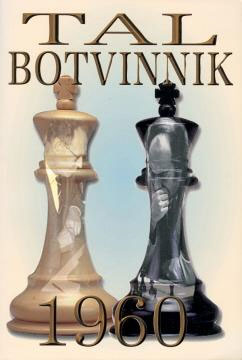
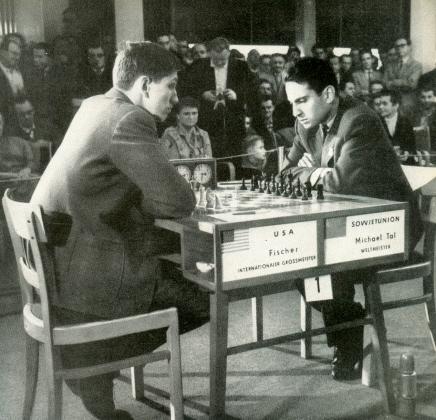
Bobby Fischer and Mikhail Tal (from page 41 of XIV. Schach-Olympiade Leipzig 1960)
(5534)
Costas Karayiannis (Loughton, England) asks for corroboration of an episode related by Tal on page 124 of his book The Life and Games of Mikhail Tal (New York, 1976). The same text, except for minor linguistic changes, appeared on page 123 of the Cadogan Chess algebraic edition (London, 1997).
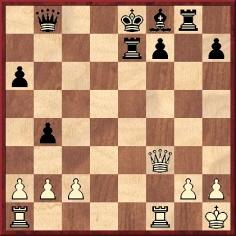
Tal reported that in this position, from a game in the Candidates’ tournament at Bled, 1959:
‘... Fischer first wrote down the move 22 Rael!, without doubt the strongest, and wrote it not in his usual English notation but in European, almost Russian. Then he not very deftly pushed the scoresheet towards me. “He’s asking for an endorsement”, I thought to myself, but how was I to react? To frown was impossible, if I smiled he would suspect “trickery”, and so I did the natural thing. I got up and began to calmly walk up and down the stage. I met Petrosian, made some joke to him, and he replied. The 15-year-old Fischer, who was essentially still only a large child, sat with a confused expression on his face ...’
Fischer then wrote down and played a different move, 22 Qc6+, and went on to lose. Tal added:
‘When I later asked Fischer why he hadn’t played 22 Rae1, he replied: “Well, you laughed when I wrote it down.”’
Our correspondent asks whether any confirmation of the incident appears in other sources. He notes that Fischer made no reference to it in My 60 Memorable Games (game 17).
(5747)
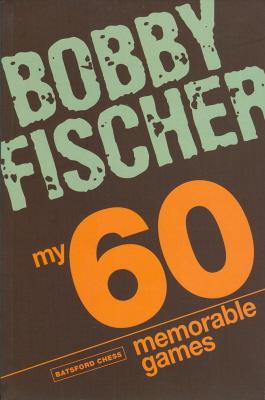
Dennis Monokroussos (South Bend, IN, USA) disputes the statement on the back cover of the 2008 edition of Fischer’s My 60 Memorable Games that ‘in contrast with the previous edition of this book, no alterations have been made to the text other than the conversion of moves into algebraic notation, making this an updated yet accurate reflection of the original book’, given that the faulty score of a 1959 Fischer v Tal game has been corrected. Our correspondent asks whether we are aware of any other changes in the new edition.
The Fischer v Tal encounter (Game 17) gave rise to the following position after 50 Kb4:
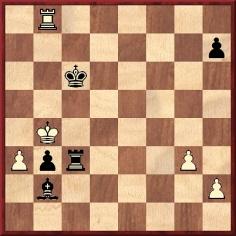
The game concluded 50...Kc7 51 Rb5 Ba1 52 a4 b2, and White resigned. Source: Page 275 of Kandidatenturnier für Schachweltmeisterschaft by S. Gligorić and V. Ragozin (Belgrade, 1960), as well as other publications of the time.
However, in the first edition of Fischer’s book (page 122) the final moves were given as ‘50...B-R8 51 P-QR4 P-N7! White resigns’. This would have allowed Fischer to win with 51 Rc8+. The fact that Tal had played 50...Kc7, and not 50...Ba1, was pointed out by B.L. Patteson on page 146 of the March 1970 Chess Life & Review, in the column ‘Larry Evans On Chess’. Evans commented:
‘Fischer assures us that he caught this error before the book went to press, but that his correction must have fallen off the page by the time it reached the printer. Anyone familiar with the monumental effort that goes into any book knows that perfection is impossible.’
The matter was also raised by D.M. Horne on page 19 of the January 1972 BCM, and the magazine’s editor confirmed that the score in Fischer’s book was faulty.
The inaccurate sequence ‘50 K-N4 B-R8 51 P-QR4 P-N7! White resigns’ was amended, in the 1972/73 Faber and Faber edition, to ‘50 K-N4 K-N4 51 R-N5 B-R8 52 P-QR4 P-N7 White resigns’. This would-be correction remained in the British publisher’s 1988 edition, but Black’s 50th move should read ...K-B2, and not the impossible ...K-N4.
The Batsford editions of 1995 and 2008 both give the conclusion of the game accurately.
As regards Mr Monokroussos’ question about other changes to the 2008 edition, we note that some further textual corrections have indeed been made. In our article on pages 45-48 of the January 1997 CHESS about the 1995 edition of Fischer’s book, we included a section entitled ‘Mistakes not corrected’:
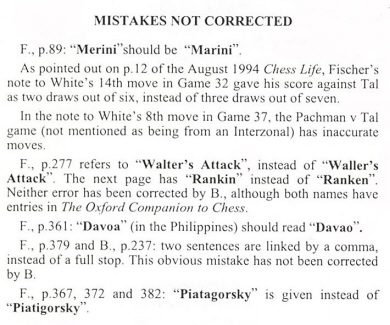
With the exception of the point regarding Game 32, the 2008 edition has corrected all these matters, silently. (See also C.N. 4867.)
Batsford was certainly right, in 2008, to wish to rectify clear-cut factual errors, but we feel that a) the back-cover claim that the text is unaltered was ill-advised, and b) any changes should have been mentioned explicitly and openly, either in footnotes or in an errata section.
(5883)
Ernest Tomlinson (Seattle, WA, USA) wishes to know the source of a quote commonly attributed to Mikhail Tal. Concerning a campaign in the Soviet Union against alcoholism, he supposedly commented that if the State was against vodka, he was on the side of vodka.
(5981)
Below is an inscription by Tal (Black against Fischer) on page 153 of our copy of Kandidatenturnier für Schachweltmeisterschaft by S. Gligorić and V. Ragozin (‘W. Ragosin’), published in Belgrade in 1960:
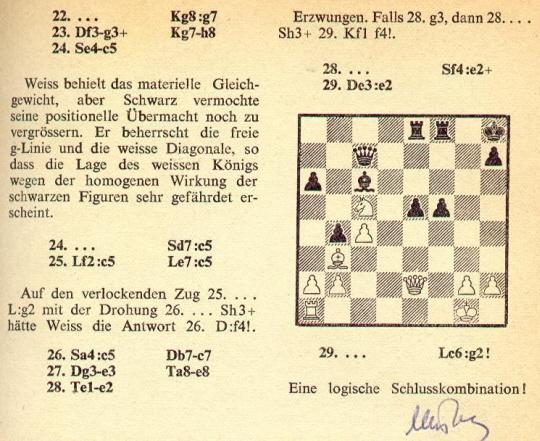
(5982)
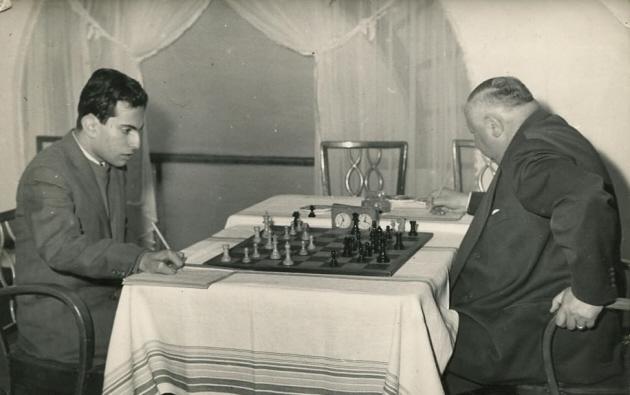
This photograph has been submitted by Lawrence Totaro (Las Vegas, NV, USA). Who was Tal’s opponent and what was the event?
(6103)
Tal’s opponent was Eugenio Szabados. In late October and early November 1957 the future world champion made a tour of Italy, and in a team match between Riga and Venice on 31 October and 1 November he defeated Szabados twice. See page 366 of Storia degli scacchi in Italia by Adriano Chicco and Antonio Rosino (Venice, 1990) and pages 164-168 of the first ‘Chess Stars’ volume of Tal’s games (1949-1962) edited by Alexander Khalifman. The latter book gave only the game in which Szabados was White.
Below is a photograph from opposite page 56 of the Venice, 1949 tournament book:
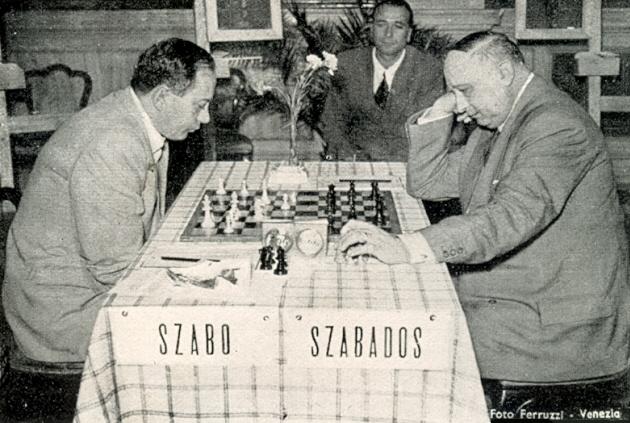
(6109)
Throughout the run of the weekly news magazine Now! (September 1979-April 1981) there was a fine chess column by William Hartston. Some observations are offered below:
‘... combinations are much easier to find if you know they are there. If only those magic words “White to play and win” would light up below the board, we would all win so many more games. In real life most of the sacrifices are not correct; only the fantasy world of the chess columnist has flashy finishes to games ...
Some years ago I was playing in the Hastings tournament with Mikhail Tal. One evening, he picked up an English newspaper, casually glanced at the chess column and started laughing. What had attracted his attention was the position given for readers to solve: it was from his own game against Platonov played at Dubna in 1973.
The amusement, however, was caused by the set of par solving times appended in order to rate one’s achievement in finding the answer. These began at 20 seconds, indicating grandmaster strength, then proceeded via master, county player and club player to stop at “average” – five minutes. “That’s very funny”, said Tal. “I spent 15 minutes looking at the position before I saw it, and my opponent didn’t see it at all.”’ (4-10 January 1980, page 98.)
The position in question was given:
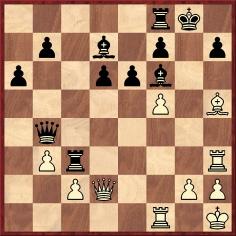
White (Tal) to move
(6742)
Concerning the above position in the previous item, Roland Kensdale (Aberdeen, Scotland) was surprised when his computer-check evaluated the game as drawn after Tal’s move 22 Rg3+. The computer’s line runs 22...Bg7 (22...Kh8 23 Qh6 was the game continuation, and Black resigned; if 23...Rxg3 24 Bg6.) 23 Rxg7+ Kxg7 24 Qg5+ Kh8 25 Qf6+ with perpetual check. If, instead, White responds to 22...Bg7 with 23 f6 ...
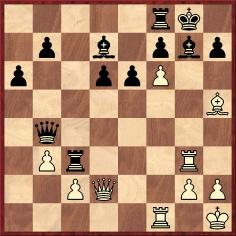
... Black has 23...Rf3.
We note that there was no mention of these lines on pages 85-86 of Tal’s Winning Chess Combinations by M. Tal and V. Khenkin (New York, 1979), but they did appear on page 70 of volume three of Alexander Khalifman’s ‘Chess Stars’ series on Tal (Sofia, 1996). The 23...Rf3 variation continued with 24 Rxg7+ Kh8 25 Qe2 Rxf1+ 26 Qxf1 Qc3, and Black was said to stand better.
(6748)
From John Blackstone (Las Vegas, NV, USA): is it possible to find the moves of the drawn game Dzindzichashvili v Tal from the 1970 Georgian Open Championship in Poti?
(6802)
Chess: Sixty Years On with Caissa and Friends by Alan Phillips (Yorklyn, 2003) is exceptionally well illustrated, and we note this comment on page 74 under a photograph of Mikhail Tal:
‘In so far as “intelligence” shone forth from a human face, it shone from his.’
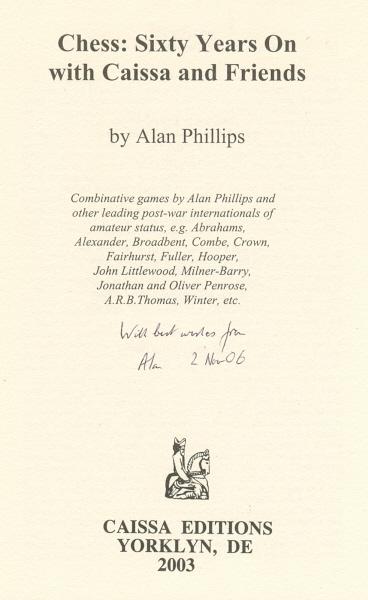
(6989)
C.N. 7150 gave a list of books about Tal which was later expanded into our feature article Books about Keres and Tal.
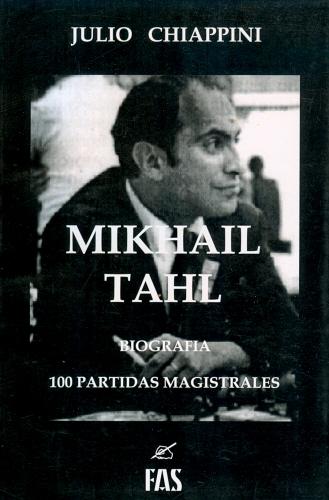
Mark Josephson (Highland Park, IL, USA) is seeking information on ‘how Mikhail Tal and his family avoided the Nazis, as they were Jews from Riga’.
We note this passage on page 21 of Tal’s 100 Best Games 1961-1973 by B. Cafferty (London, 1975):
‘In 1969 Tal gave a long interview for the correspondent of the Latvian young people’s paper Padomju Jaunatne which was later reproduced in the Latvian chess magazine ...
“Q. Tell us about your personal background.”
“A. I was born 9 November 1936 in Riga in a doctor’s family. During the Great Fatherland War (i.e. 1941-45) I was evacuated to Yurla (central Ural region). I first went to school at seven and was soon put into the third class. I returned to Riga as soon as it was freed in November 1944 ...”’
Wanted: accounts giving more details.
(7672)
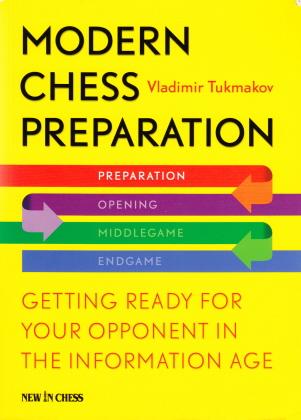
C.N. readers will have seen here most of the photographs of the old-timers used in Modern Chess Preparation by Vladimir Tukmakov (Alkmaar, 2012). They may also note that the picture of Tal on page 70 has been reversed, and below we give the correct version (Tal in play against Sliwa in the 1960 Leipzig Olympiad), from page 29 of the tournament book:
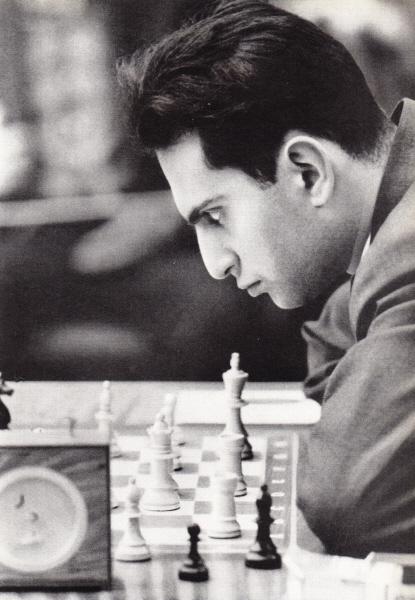
(7846)
Dan Scoones forwards a neglected game for which each player had only five minutes:
Mikhail Tal – Boris Spassky
Rapid championship of Moscow, 1957
Ruy López
1 e4 e5 2 Nf3 Nc6 3 Bb5 f5 4 Nc3 Nd4 5 exf5 Nf6 6 Nxe5 Bc5 7 O-O O-O 8 Nf3 c6 9 Nxd4 Bxd4 10 Ne2 Be5 11 Bc4+ d5 12 Bd3 c5 13 Ng3 c4 14 Be2 Bxg3 15 hxg3 Bxf5 16 d3 b5 17 a4 a6 18 axb5 axb5 19 Rxa8 Qxa8 20 dxc4 dxc4 21 Bf3
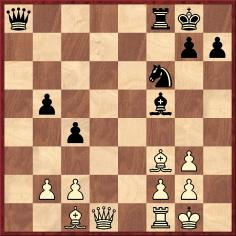
21...Qa2 22 Re1 Qb1 23 Qd6 Qxc2 24 Bd5+ Nxd5 25 Qxd5+ Kh8
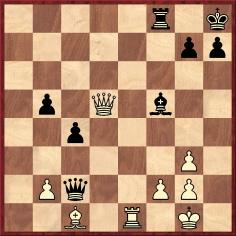
26 Qf7 Rg8 27 Bh6 and White won.
Source: Chess Life, February 1963, page 38.
The game appeared in an article by Eliot Hearst which reported that the moves had been recorded by B. Weinstein. It was also noted that the same opening had occurred in the game between Tal and Spassky in the USSR championship earlier in 1957.
At move 15 Hearst commented: ‘For the last five moves the two players had consumed two minutes, a considerable time; for the next six moves they used some ten seconds only.’ Spassky spent some time on 21...Qa2, and ‘Tal also thought a while on his reply and prepared a pretty and decisive trap’.
(8513)
From Olimpiu G. Urcan (Singapore):
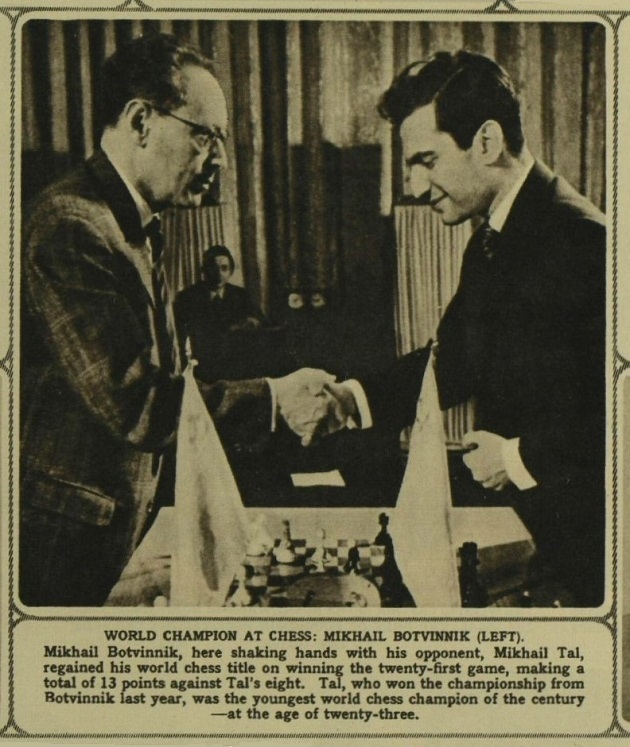
Illustrated London News, 20 May 1961, page 851
(9037)
Chess and Time includes reports on leading players who seldom, if ever, lost on time in tournament or match play. An addition comes from page 11 of The Life and Games of Mikhail Tal by M. Tal (New York, 1976):
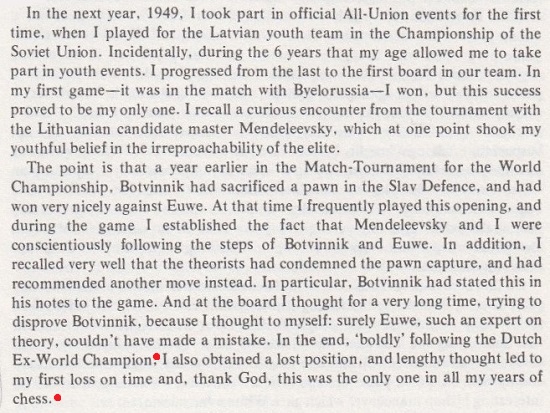
The passage is on pages 20-21 of the 1997 Cadogan edition of Tal’s book.
When the game between Mendeleevsky and Tal (Riga, June 1949) was given on pages 12-13 of Mikhail Tal Tvortshestvo 1949-1961 (Riga, 1996) Black’s loss on time was mentioned:
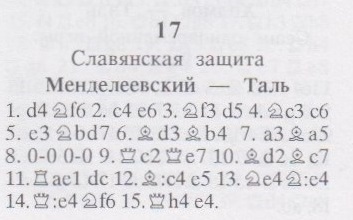
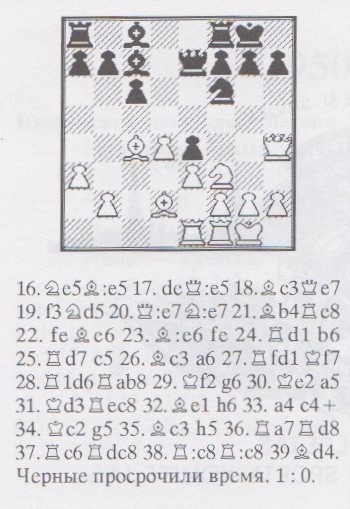
(9539)
From page 25 of The Life and Games of Mikhail Tal by M. Tal (New York, 1976):
‘On the whole, I do not like annotating other people’s games. The point is that I consider that it is very difficult to penetrate into a player’s thinking, to guess the direction of the variations thought out by him, and therefore it is better to be indulgent towards one’s own games. I prefer to make my annotations “hot on the heels”, as it were, when the fortunes of battle, the worries, hopes and disappointments are still sufficiently fresh in my mind.’
On page 34 of the London, 1997 edition the wording was slightly different: ‘... it is better to direct one’s attention towards ...’
(9569)
On page 29 of Chess World, February 1960 C.J.S. Purdy wrote:
‘If – we almost wrote “when” – Botvinnik loses the current match, he will have the right to a return match in 1961 ...
Tal seems generally favoured to beat Botvinnik. We think stamina will decide in Tal’s favour ...’
And from page 73 of the May 1960 issue:
‘This was the only world title match about which we have ever ventured a prophecy.’
On page 57 of the April 1960 Chess World Purdy criticized Harry Golombek, under the heading ‘Extraordinary Prediction’:
‘At that stage [after the short draw in the 13th match-game], with Tal two games ahead, Golombek published an extraordinary prediction that Botvinnik would hold his title. Golombek faces the alternative prospect of becoming known as either the greatest prophet or the greatest neck-out-sticker in chess history.
... One of the reasons that Golombek gives is that Botvinnik has a better knowledge than Tal of the openings that are being played! Here is logic to make poor old John Hanks writhe in agony. It would be just as sound to say one tennis player should beat another because his service is superior.
... Golombek’s writings all tend to show that he regards chess rather too much as a body of knowledge. If knowledge of the openings went far, Golombek himself would be one of the world’s best players.
Chess is primarily a skill. It’s mainly a matter of who sees the mostest the fastest. Tal sees the mostest the fastest of all. He would have done better still had he played more soberly after amassing a three-point lead.
Seeing the mostest the fastest is not the whole story. Petrosian may be Tal’s equal there. That is technique. After that comes the art of choosing between moves that technique ranks equal, or as possibly equal. Petrosian, like Capablanca, will always choose the calculable. Tal will often choose the incalculable. Such a player develops an intuition for chances. Tal’s intuition is not perfect, as we see from the ninth game, below, but many of his other games show that it is almost magical, all the same.
Golombek’s prediction may possibly come true, but the reasoning he bases it on is faulty. He seems to be a Botvinnik fanatic.’
It is unclear to us which particular text or texts by Golombek prompted Purdy’s remarks. Our reading of the game-by-game reports by Golombek from Moscow in the BCM and The Times is that he was even-handed and not remotely a ‘Botvinnik fanatic’.
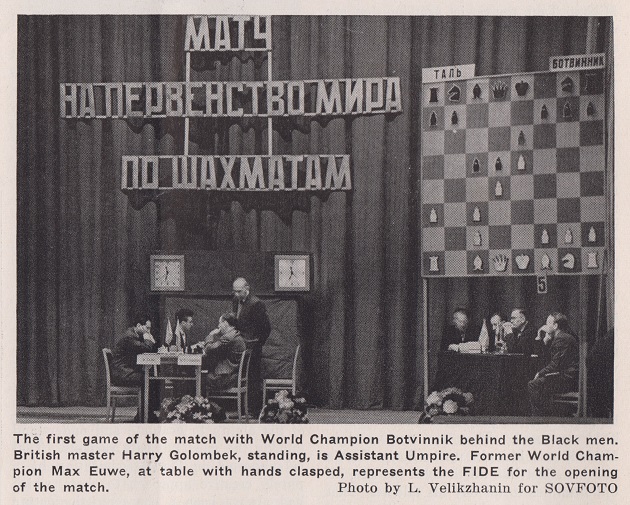
Chess Review, May 1960, page 136
(9835)
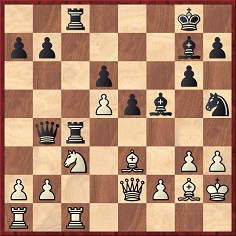
Black to move
In this position from the sixth match-game between Botvinnik and Tal (Moscow, 26 March 1960) Purdy wrote regarding 21...Nf4:
‘Perhaps the most daring sacrifice ever made in a world championship match, for the consequences were certainly not fully calculable. It is easy to see that Black gets two pawns for his piece, but White retains his two bishops and there is no crash on White’s king.’
Source: Chess World, March 1960, page 47.
(9836)
Olimpiu G. Urcan has submitted a photograph published on page 95 of the Illustrated London News, 21 January 1961:
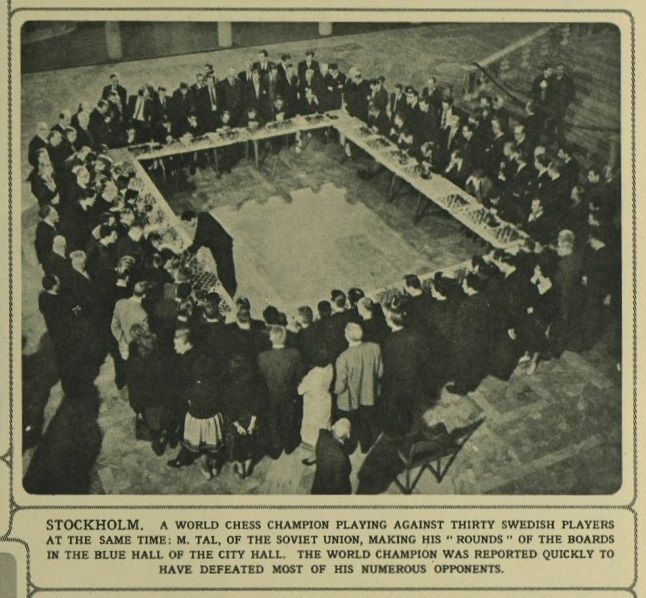
(9838)
From page 178 of Yearbook of Chess Wisdom by Peter Zhdanov (Niepołomice, 2015):

(9853)
More and more archive film on chess is coming to light, including particularly interesting footage from the Candidates’ tournament, Bled in 1959.
Two screen-shots:
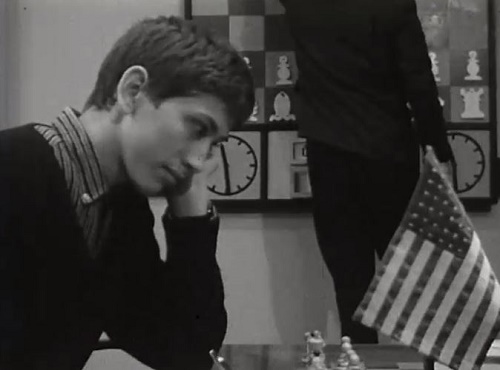
Bobby Fischer

Mikhail Tal
(9886)
Dan Scoones writes:
‘On page 33 of Tibor Károlyi’s first volume on the life and games of Mikhail Tal, The Magic of Youth (Glasgow, 2014), one early opponent is misidentified:
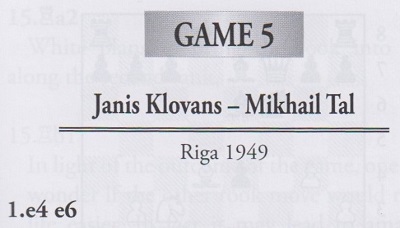
Tal’s opponent was not his future trainer Jānis Klovāns (1935-2010) but another strong master with a similar name: Jānis Kļaviņš (1933-2008). The game Kļaviņš-Kamrad from the same event (“чемпионат школьников Риги”) was published on page 159 of the June 1949 issue of Shakhmaty v SSSR. I have found no suggestion that Klovāns also played in that event.
Jānis Kļaviņš was the Latvian champion in 1952. The Cyrillic version of his name is Янис Клявиньш, which some compilers have rendered as Janis Kliavinsh or simply Janis Kliavin (see, for example, page 3 of Hilary Thomas’s first volume of Tal’s games).
Another game between Kļaviņš and Tal, from the 1953 Latvian championship, was published on page 180 of the June 1953 issue of Shakhmaty v SSSR with annotations by Alexander Koblents.’
(10099)
On page 72 of the March 1962 Chess Review Bruce Hayden reported that on the evening of 28 December 1961 John Littlewood was referred to by visiting masters as ‘der kleine Tal’ after his spectacular, though unsuccessful, attack against Botvinnik in the Hastings tournament. The world champion annotated the game on pages 129-130 of CHESS, 19 January 1962.
(11201)
One of a set of caricatures from page 11 of Destino (Barcelona), 25 January 1964:
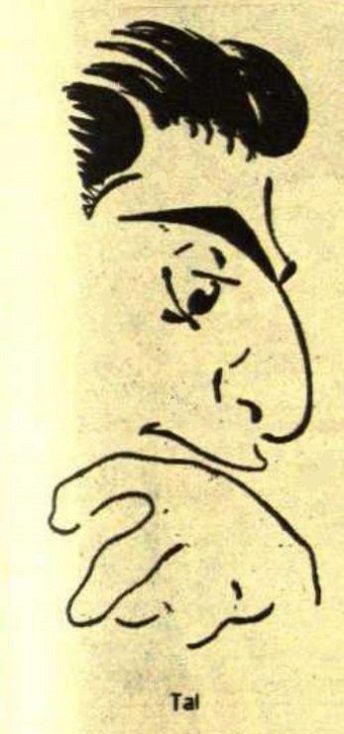
(11371)
C.N. 8045 referred to an article ‘Close to the Grandmasters’ on pages 142-143 of the April 1968 Chess Life which comprised a translation of interviews by Yuri Zarubin with Tal, Gheorghiu, Euwe, Pachman and Najdorf. Two extracts:
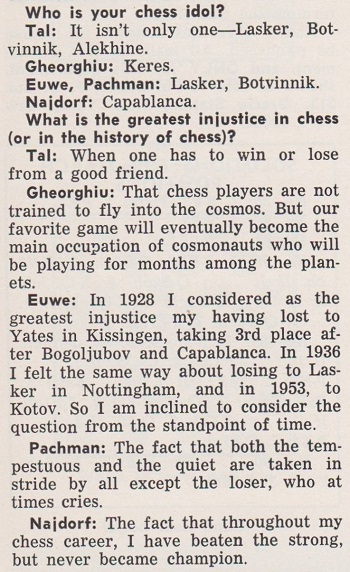
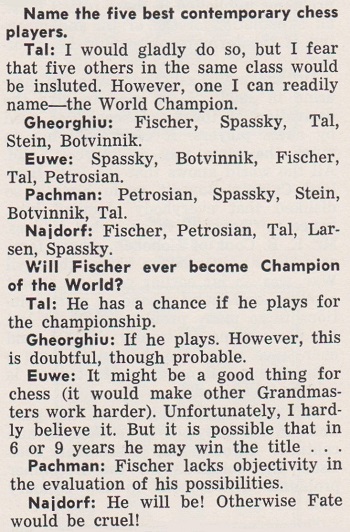
Michael Kühl (Berlin) provides the original article, from page 5 of Izvestia, 29 November 1967:
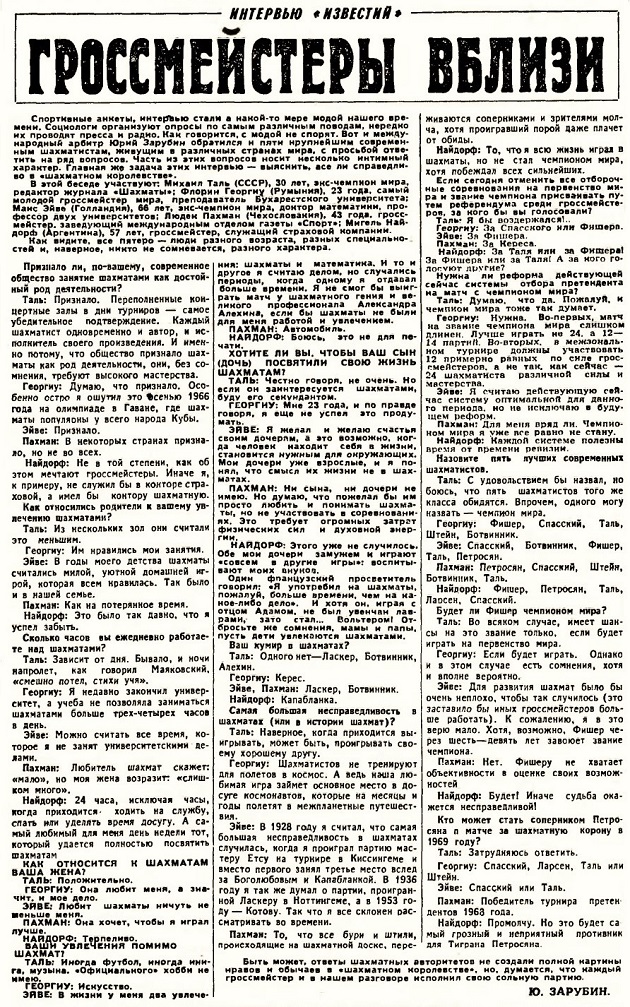
(11480)
Gerd Entrup (Herne, Germany) notes that Euwe’s (famous) loss to Kotov was not in 1953, as reported in the interview, but in 1946, in the Groningen tournament.
(11484)
From page 129 of The Chess Scene by David Levy and Stewart Reuben (London, 1974):

The unspecified source proves a disappointment: the alleged Tal remark is on page 44 of the End-October 1965 issue of CHESS, in an article by Dimitrije Bjelica. It follows a brief reference to Tal’s win against Héctor Rossetto at the 1958 Interzonal tournament in Portorož and begins, ‘“You play like Lasker”, we said to Tal ...’
There was a different wording on page 237 of Bjelica’s Grandmasters in Profile (Sarajevo, 1973): ‘They say that Lasker is going to lose in every other game, about me they say that I am going to lose in every one.’
(11585)
Olimpiu G. Urcan provides this portrait of Mikhail Tal, courtesy of the Daily Telegraph archive:
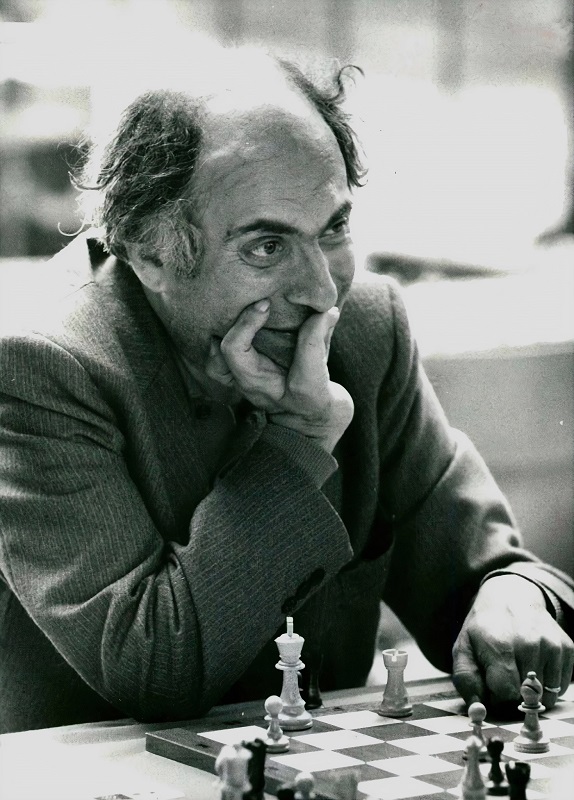
(11942)
From Chess: the Need for Sources:
As shown in Dimitrije Bjelica – A Unique Chess Writer, page 171 of Dimitrije Bjelica’s Wonderful world of chess quotes Mikhail Tal:
‘There are two kind of sacrifices – the corrects ones, and mine’s.’
Before being tossed into the Bjelica mangling machine, the Tal quote was something like:
‘There are two kinds of sacrifices – sound ones, and mine.’
We write ‘something like’ because other wordings can be found, such as ‘two types of sacrifice’, but the above version is what Anthony Saidy gave on page 303 of the June 1973 Chess Life & Review. However, he merely reported there that Tal ‘once said’ it.
Chess literature teems with things that players purportedly ‘once said’, ‘said on one occasion’, ‘used to say’, ‘liked to say’ and other vague variants, but what is the truth about the remark ascribed to Tal? When did he say, or write, such a thing, and in which language? When was it first recorded in print? What was the context? Did it relate to a specific game? What indication, if any, did Tal give that such a statement was made in jest (or, as anecdotalists like to say, ‘with a twinkle in his eye’)?
From the front cover of the October 1966 issue of CHESS:

The unnamed author was P.H. Clarke.
Concerning the observation by C.H.O’D. Alexander – ‘It passes one of the best tests of a well-annotated book: the winner’s moves are quite frequently criticised’ – that full review is sought. The words were not in the chess column on page 39 of the Sunday Times Magazine, 7 May 1961, where Alexander compared the Clarke book favourably to Selected Games of Mikhail Tal by J. Hajtun (London, 1961).
(12154)
See too Chess Annotations.
To the Archives
for other feature articles.
Copyright Edward Winter. All rights reserved.